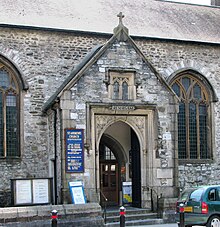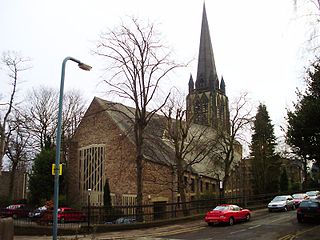
Church of St Mark is a Church of England parish church in the Sheffield suburb of Broomhill, in England.

John Egerton Christmas Piper CH was an English painter, printmaker and designer of stained-glass windows and both opera and theatre sets. His work often focused on the British landscape, especially churches and monuments, and included tapestry designs, book jackets, screen prints, photography, fabrics and ceramics. He was educated at Epsom College and trained at the Richmond School of Art followed by the Royal College of Art in London. He turned from abstraction early in his career, concentrating on a more naturalistic but distinctive approach, but often worked in several different styles throughout his career.
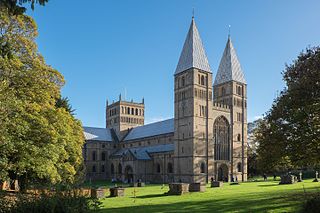
Southwell Minster, strictly since 1884 Southwell Cathedral, and formally the Cathedral and Parish Church of the Blessed Virgin Mary, is a Church of England cathedral in Southwell, Nottinghamshire, England. The cathedral is the seat of the bishop of Southwell and Nottingham and the mother church of the diocese of Southwell and Nottingham; it is governed by a dean and chapter. It is a grade I listed building.

Ewan Christian (1814–1895) was a British architect. He is most frequently noted for the restorations of Southwell Minster and Carlisle Cathedral, and the design of the National Portrait Gallery. He was Architect to the Ecclesiastical Commissioners from 1851 to 1895. Christian was elected A RIBA in 1840, FRIBA in 1850, RIBA President 1884–1886 and was awarded the Royal Gold Medal in 1887.

Charles Church is a now derelict church in the UK. It was the second oldest parish church in Plymouth, Devon, England.

Leeds Minster, also known as the Minster and Parish Church of Saint Peter-at-Leeds is the minster church of Leeds, West Yorkshire, England. It stands on the site of the oldest church in the city and is of architectural and liturgical significance. A church is recorded on the site as early as the 7th century, although the present structure is a Gothic Revival one, designed by Robert Dennis Chantrell and completed in 1841. It is dedicated to Saint Peter and was the Parish Church of Leeds before receiving the honorific title of "Minster" in 2012. It has been designated a Grade I listed building by Historic England.

Church of the Holy Cross, Crediton, formally the Collegiate Church of the Holy Cross and the Mother of Him Who Hung Thereon, is the parish church of the town of Crediton in Devon, England. The church is built on the site of what was the cathedral of the Bishop of Crediton in the former diocese until 1050 when the see was transferred to Exeter. A college of canons remained at Crediton, administering the buildings and life of the "collegiate" church.
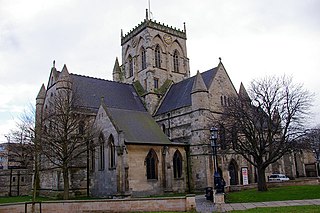
Grimsby Minster is a minster and parish church located in Grimsby, North East Lincolnshire, England. Dedicated to St James, the church belongs to the Church of England and is within the Diocese of Lincoln.
Nicholas Patrick Reyntiens OBE was a British stained-glass artist, described as "the leading practitioner of stained glass in this country."

St John the Baptist Church, is in the village of Hartford, Cheshire, England. The church is recorded in the National Heritage List for England as a designated Grade II listed building, and is the Anglican parish church of Hartford and Greenbank. It is in the diocese of Chester, the archdeaconry of Chester and the deanery of Middlewich.
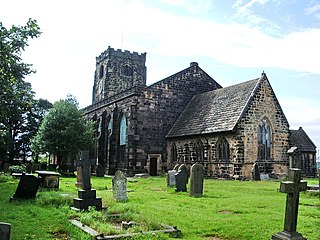
St Andrew's Church is an Anglican church in Leyland, Lancashire, England. It is an active Anglican parish church in the Diocese of Blackburn and the archdeaconry of Blackburn. The church is recorded in the National Heritage List for England as a designated Grade II* listed building.

Preston Minster, formally the Minster Church of St John the Evangelist, is in Church Street, in the centre of Preston, Lancashire, England. From its origin it has been the parish church of Preston. It is an active Anglican church in the deanery of Preston, the archdeaconry of Lancaster and the diocese of Blackburn. Its benefice is united with that of St George, Preston. St John's is recorded in the National Heritage List for England as a designated Grade II* listed building.

St Andrew's Church is in Blackpool Road, Ashton-on-Ribble, Preston, Lancashire, England. It is an active Anglican parish church in the deanery of Preston, the archdeaconry of Lancaster, and the diocese of Blackburn. The church is recorded in the National Heritage List for England as a designated Grade II listed building.

St James' Church is in the village of Burton-in-Kendal, Cumbria, England. It is an active Anglican parish church in the deanery of Kendal, the archdeaconry of Westmorland and Furness, and the diocese of Carlisle. Its benefice is united with that of Holy Trinity, Holme. The church is recorded in the National Heritage List for England as a designated Grade I listed building.
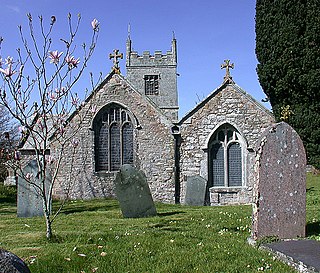
Colan Church also known as St Colan Church is a 13th-century church in Colan, mid-Cornwall, UK. Dedicated to St Colanus, it became a Grade I listed building in 1967. The vicars of St Columb Minor have served the church since the middle of the 20th century.

St Peter and St Paul's Church, Aldeburgh is a Grade II* listed parish church in the Church of England in Aldeburgh, Suffolk.

St Mary's Church is a Grade I listed building, a parish church in the Church of England in Ottery St Mary, Devon.
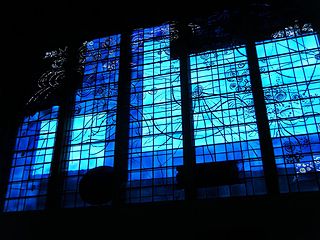
St Andrew's Church, Wolverhampton is a parish church in the Church of England in Wolverhampton
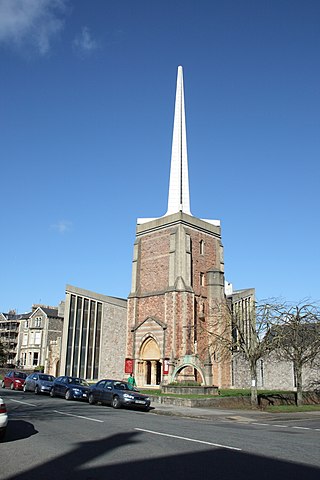
The Church of All Saints is a Church of England parish church in Clifton, Bristol. The church is a grade II listed building. It is located in the Parish of All Saints with St. John Clifton in the Diocese of Bristol.

St Mary's Church is an Anglican parish church in the English village of Welwick in the East Riding of Yorkshire. It is a Grade I listed building.


